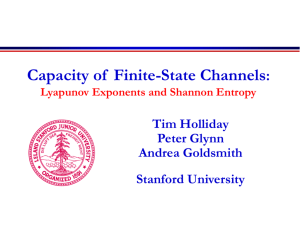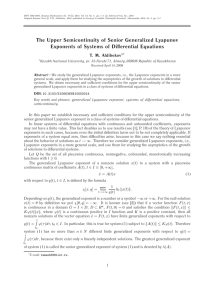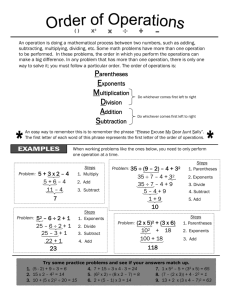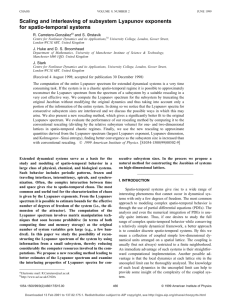Lyapunov exponents of position dependent random
advertisement
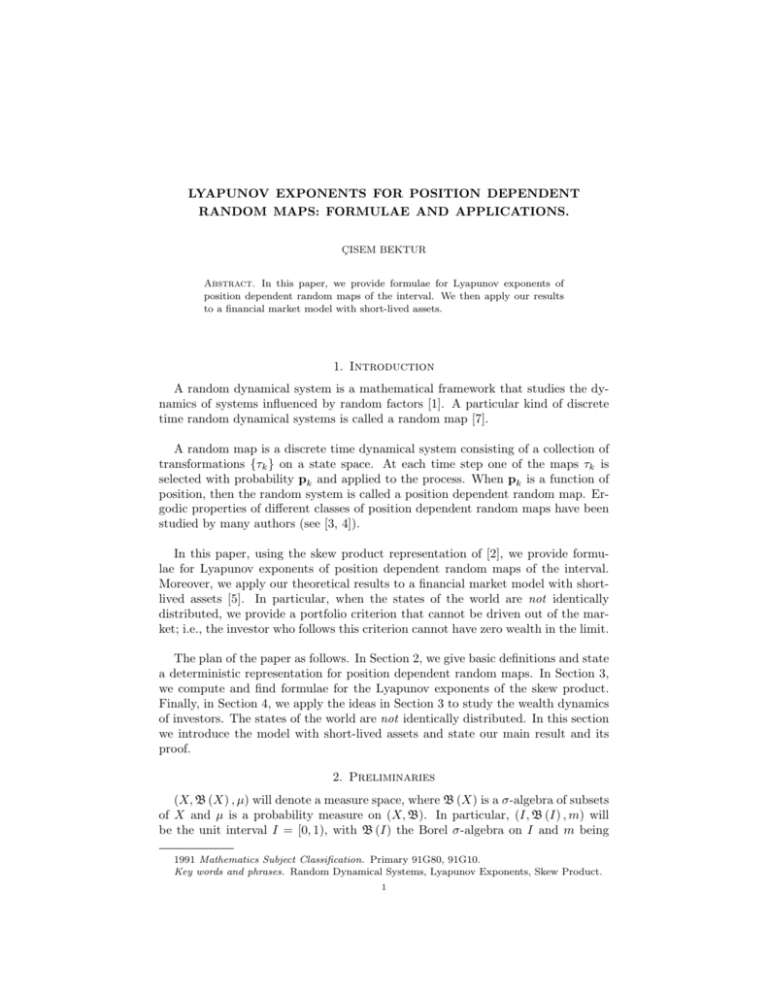
LYAPUNOV EXPONENTS FOR POSITION DEPENDENT
RANDOM MAPS: FORMULAE AND APPLICATIONS.
ÇISEM BEKTUR
Abstract. In this paper, we provide formulae for Lyapunov exponents of
position dependent random maps of the interval. We then apply our results
to a financial market model with short-lived assets.
1. Introduction
A random dynamical system is a mathematical framework that studies the dynamics of systems influenced by random factors [1]. A particular kind of discrete
time random dynamical systems is called a random map [7].
A random map is a discrete time dynamical system consisting of a collection of
transformations {τk } on a state space. At each time step one of the maps τk is
selected with probability pk and applied to the process. When pk is a function of
position, then the random system is called a position dependent random map. Ergodic properties of different classes of position dependent random maps have been
studied by many authors (see [3, 4]).
In this paper, using the skew product representation of [2], we provide formulae for Lyapunov exponents of position dependent random maps of the interval.
Moreover, we apply our theoretical results to a financial market model with shortlived assets [5]. In particular, when the states of the world are not identically
distributed, we provide a portfolio criterion that cannot be driven out of the market; i.e., the investor who follows this criterion cannot have zero wealth in the limit.
The plan of the paper as follows. In Section 2, we give basic definitions and state
a deterministic representation for position dependent random maps. In Section 3,
we compute and find formulae for the Lyapunov exponents of the skew product.
Finally, in Section 4, we apply the ideas in Section 3 to study the wealth dynamics
of investors. The states of the world are not identically distributed. In this section
we introduce the model with short-lived assets and state our main result and its
proof.
2. Preliminaries
(X, B (X) , µ) will denote a measure space, where B (X) is a σ-algebra of subsets
of X and µ is a probability measure on (X, B). In particular, (I, B (I) , m) will
be the unit interval I = [0, 1), with B (I) the Borel σ-algebra on I and m being
1991 Mathematics Subject Classification. Primary 91G80, 91G10.
Key words and phrases. Random Dynamical Systems, Lyapunov Exponents, Skew Product.
1
2
Lyapunov exponents for position dependent random maps
Lebesgue measure on (I, B (I)). For s = 1, . . . , L, let τs : X → X be measurable
PL
transformations and ps : X → I be measurable functions such that s=1 ps (r) =
1, that is, a measurable partition of unity.
2.1. Position dependent random maps. We let F = {τ1 , . . . , τL ; p1 , . . . , pL }
denote the associated random map. A random map is more precisely a discrete
time Markov process with transition function
P (r, A) =
L
X
ps (r) XA (τs (r)) ,
s=1
where XA denotes the charasteristic function of a measurable set A.
2.2. A Deterministic Representation For Position Dependent Random
Maps. Following [2] we can represent the position dependent random map by a
skew product as follows. We make use of the following simple lemma:
Lemma 2.1. Let Y and Z be a measurable spaces and let (Js )s∈κ be a finite
(or countable), measurable partition of Y . For each s ∈ κ, assume that Fs is a
measurable map from Js to Z. Then the piecewise-defined map F : Y → Z defined
by F (r) = Fs (r) if r ∈ Js is measurable.
P In our construction,
P Y = Z = X ×I and the set Js will be given by Js = {(r, w) :
p
(r)
≤
w
≤
i<s i
i≤s pi (r)}. We define maps ϕs : Js → I by
Ps−1
p (r)
1
(2.1)
ϕs (r, w) =
w − l=1 l
.
ps (r)
ps (r)
The maps Fs are defined on Js by Fs (r, w) = (τs (r) , ϕs (r, w)). By
ϕr (w) : [0, 1] → [0, 1]
we will denote the piecewise linear expanding map, whose L branches are given by
ϕs (r, w) ,
s = 1, . . . , L.
It is well known ([9]) that for such a piecewise linear expanding map Lebesgue
measure is invariant and ergodic. Define the skew product transformation R :
X × I → X × I by
(2.2)
R (r, w) = (τs (r) , ϕs,r (w)) ,
for (r, w) ∈ Js . R is then B (X) × B (I)-measurable.
2.3. Lyapunov Exponents of an Endomorphism. In this subsection, we recall
the definition of Lyapunov exponents of an endomorphism [8].
Definition 2.2. Let f : M → M be an endomorphism on a manifold M of dimension m. Let |.| be the norm on tangent vectors induced by a Riemannian metric on
M . For each r ∈ M and v ∈ Tr M let
1
(2.3)
l (r, v) = lim ln |Dfrt v| ,
t→∞ t
whenever the limit exists.
Remark 2.3. The multiplicative ergodic theorem of Oseledec [8] says that, for almost
all r ∈ M :
i) the limit in (2.3) exists for all tangent vectors v ∈ Tr M , and
Ç. Bektur
3
ii) there are at most m distinct values of l (r, v) for one point r.
Let m (r) be the number of distinct values of l (r, v) at r for v ∈ Tr M , with
tangent vectors v j ∈ Tr M for 1 ≤ j ≤ m (r) giving distinct values:
lj (r) = l r, v j
with
l1 (r) < l2 (r) . . . < lm(r) (r) .
These distinct values are called the Lyapunov exponents at r.
3. Computing the lyapunov exponents of the skew product
In this section, we are going to assume that X = [0, 1] and that
τs : [0, 1] → [0, 1]
are differentiable maps. In the next proposition, we will obtain formulae for the
Lyapunov exponents of the skew product R.
Proposition 3.1. Let R : [0, 1] × [0, 1] → [0, 1] × [0, 1] be defined as in (2.2). Then
(1)
t−1
0
1X
l1 (r, w) ≥ lim
ln |τsi τsi−1 (r) |,
t→∞ t
i=0
(2)
l2 (r, w) = lim
t→∞
1
1
1
...
ln
.
t pst−1 τst−2 ◦ τst−3 . . . τs0 (r)
ps0 (r)
Proof. For (r, w) ∈ Js we have
R (r, w) = (τs (r) , ϕs,r (w)) .
Let us first compute the derivative matrix of R. We have
0
0
τs0 (r)
A (r, w) = ∂
.
∂
∂r ϕs0 ,r (w)
∂w ϕs0 ,r (w)
1
Let v1 =
, then
0
0
τs0 (r)
(3.1)
A (r, w) v1 = ∂
.
∂r ϕs0 ,r (w)
Also
(3.2)
0
τs1 (τs0 (r))
A (R (r, w)) = ∂
ϕ
∂r s1 ,τs0 (r) (ϕs0 ,r (w))
0
∂
∂w ϕs1 ,τs0 (r)
(ϕs0 ,r (w))
.
Therefore, by (3.1) and (3.2) we have
A (R (r, w)) A (r, w) v1 =
(3.3)
!
0
0
τs1 (τs0 (r)) τs0 (r)
0
.
∂
∂
∂
∂r ϕs1 ,τs0 (r) (ϕs0 ,r (w)) τs0 (r) + ∂w ϕs1 ,τs0 (r) (ϕs0 ,r (w)) ∂r ϕs0 ,r (w)
Thus, in general, we have
(3.4)
t−1
A R
(r, w) . . . A (R (r, w)) A (r, w) v1 =
A1
,
A2
4
Lyapunov exponents for position dependent random maps
where
0
0
0
A1 = τst−1 τst−2 (r) . . . τs1 (τs0 (r)) τs0 (r)
and A2 includes terms which are analogous to the second component in (3.3).
Therefore, using (3.4) we obtain
kA Rt−1 (r, w) . . . A (R (r, w)) A (r, w) v1 k
0
0
0
(3.5)
≥ |τst−1 τst−2 (r) . . . τs1 (τs0 (r)) τs0 (r) |.
Since ln is an increasing function, using (3.5), we obtain
0
0
0
1
ln |τst−1 τst−2 (r) . . . τs1 (τs0 (r)) τs0 (r) |
t
t−1
0
1X
= lim
ln |τsi τsi−1 (r) |,
t→∞ t
i=0
l1 (r, w) ≥ lim
t→∞
where we have used the
notation τ−1 (r) = r. For l2 (r, w), we first compute
0
A (r, w) v2 , where v2 =
. We have
1
0
A (r, w) v2 = ∂
,
∂w ϕs0 ,r (w)
and by (3.2)
A (R (r, w)) A (r, w) v2 =
0
∂
∂w ϕs1 ,τs0 (r)
∂
(ϕs0 ,r (w)) ∂w
ϕs0 ,r (w)
.
Thus, in general, we have
A Rt−1 (r, w) . . . A (R (r, w)) A (r, w) v2 =
0
(3.6)
∂
∂w ϕst−1 ,τst−2 ◦...◦τs0 (r)
ϕst−2 ,τst−3 ◦...◦τs0
!
.
∂
(w) . . . ∂w
ϕs0 ,r (w)
Moreover, by the definition of ϕs,r (w) (see (2.1)), we have
∂
1
ϕs,r (w) =
.
∂w
ps (r)
(3.7)
Therefore, by (3.6) and (3.7) we have
l2 =
1
1
1
...
ln
.
t pst−1 τst−2 ◦ . . . ◦ τs0 (r)
ps0 (r)
The next proposition shows that at common fixed points of maps τs , the Lyapunov exponents have more precise formulae.
Proposition 3.2. Let r0 be a common fixed point for all the constituent maps τs ;
i.e., τs (r0 ) = r0 for all s ∈ S. Then
PL
0
(1) l1 (r0 , w) ≥ s=1 ps (r0 ) ln |τs (r0 ) |
PL
(2) l1 (r0 , w) = − s=1 ps (r0 ) ln ps (r0 )
Ç. Bektur
5
Proof. By Proposition 3.1, since τs (r0 ) = r0 , we have
t−1
(3.8)
0
1X
ln |τsi (r0 ) |,
t→∞ t
i=0
l1 (r0 , w) ≥ lim
where s0 → s1 → . . . → st−1 is the orbit of s0 generated by the map ϕr0 (w). Since
Lebesgue measure m is ϕr0 -invariant and ergodic, we can use the Birkhoff Ergodic
Theorem and (3.8) to obtain that
t−1
0
1X
ln |τsi (r0 ) |
t→∞ t
i=1
Z 1
0
=
ln |τw (r0 ) |dm (w) .
l1 (r0 , w) ≥ lim
(3.9)
0
Write m := mr0 to associate [0, 1] with the particular partition of ϕr0 . Then, using
the partition Js defined in Subsection 2.2 and (3.9) we get
Z 1
0
l1 (r0 , w) ≥
ln |τw (r0 ) |dmr0 (w)
0
=
L Z
X
Js
s=1
=
L
X
0
ln |τw (r0 ) |dmr0 (w)
0
ps (r0 ) ln |τs (r0 ) |.
s=1
Similarly, for l2 (r0 , w), we use Proposition 3.1 and Birkhoff Ergodic Theorem to
obtain that
Z 1
l2 (r0 , w) = −
ln pw (r0 ) dmr0
0
=−
L
X
ps (r0 ) ln ps (r0 ) .
s=1
Remark 3.3. Obviously, we always have l2 (r0 , w) > 0. Thus, if l1 (r0 , w) > 0 then
nearby points cannot be attracted to (r0 , w) under the dynamics of R. In particular,
this will mean that nearby points r ∈ [0, 1] cannot be attracted to r0 under the
dynamics of the random map F .
4. Financial Applications
We will apply these ideas to study the wealth dynamics of investors, where the
states of the world are not identically distributed. In particular, they will depend
on the amount of money invested in the assets. To simplify this idea, let us first
reconsider the Kelly model [6] in a more realistic setting. In particular, let us
consider a horse race model where the odds of the outcomes of the events depend
on the amount wagered on them. For example, in the case of a horse race between
two horses, say black and white, this means that the probability that black wins is
a function of the amount bet on black. Such a setting is common in real-life betting
games. We will investigate this situation in a more general setting. In particular,
in the financial model of [5].
6
Lyapunov exponents for position dependent random maps
4.1. Model. We use the model in [5]. Let S is finite set and st ∈ S, t = 1, 2, . . ., be
the states of the world at date t. Let p be a probability distribution on S such that
for all s ∈ S, ps > 0. s1 , s2 , . . . are independent but their probability distribution
will change at each time step according to the money invested in the assets. This
will be made more explicit later in the model.
There are i = 1, . . . , I investors initially endowed with wealth w0i > 0 and K shortlived assets k = 1, . . . , K live for one period only and reborn in every period. They
yield the non-negative return Dk (s) at state
P s, and we assume that Dk (s) 6= 0 for
at least one s. Moreover, we assume that k Dk (s) > 0 for all s.
At each time t, every investor i selects a portfolio
xit st = xit,1 st , . . . , xit,K st ∈ RK
+,
where xit,k is the number of units of asset k in the portfolio xit = xit (st ), (st ) =
(s1 , . . . , st ). We assume that for each moment of time t ≥ 1 and each random
situation st , the market for every asset k clears:
I
X
(4.1)
xit,k st = 1.
i=1
i
Each investor is endowed with initial wealth w0i > 0. Wealth wt+1
of investor i at
time t + 1 can be computed as follows:
(4.2)
i
wt+1
=
K
X
Dk (st+1 ) xit,k .
k=1
Total market wealth at time t + 1 is equal to
(4.3)
Wt+1 =
I
X
i
wt+1
=
i=1
K
X
Dk (st+1 ) .
k=1
Investment strategies are characterised in terms of investment proportions:
Λi = {λi0 , λi1 , . . .}
of K-dimensional vector functions λit = λit,1 , . . . , λit,K , λit,k = λit,k (st ), t ≥ 0,
PK
satisfying λit,k > 0, k=1 λit,k = 1. Here, λit,k stands for the share of the budget wti
of investor i that is invested into asset k at time t. In general λit,k may depend on
(st ) = (s1 , . . . , st ). Given strategies Λi = {λi0 , λi1 , . . .} of investors i = 1, . . . , I, the
equation
(4.4)
pt,k .1 =
I
X
λit,k wti
i=1
determines the market clearing price pt,k = pt,k (st ) of asset k. The number of units
of asset k in the portfolio of investor i at time t is equal to
(4.5)
xit,k =
λit,k wti
.
pt,k
Therefore
(4.6)
λit,k wti
xit,k = PI
.
j
j
j=1 λt,k wt
Ç. Bektur
7
By using (4.6) and (4.2), we get
i
wt+1
=
(4.7)
K
X
λit,k wti
Dk (st+1 ) PI
.
j
j
j=1 λt,k wt
k=1
Since w0i > 0, we obtain wti > 0 for each t. The main focus of the model is on the
analysis of the dynamics of the market shares of the investors
rti =
wti
,
Wt
i = 1, . . . , I.
Using (4.7) and (4.3), we obtain
(4.8)
i
rt+1
=
K
X
λit,k rti
,
Rk (st+1 ) PI
j
j
j=1 λt,k rt
k=1
i = 1, . . . , I,
where
Dk (st+1 )
Rk (st+1 ) = PK
m=1 Dm (st+1 )
are theP
relative (normalised) payoffs of the assets k = 1, 2, . . . , K. We have Rk (s) ≥
0 and k Rk (s) = 1. Assume I = 2. Then the random dynamical system (4.8)
reduces to
1
rt+1
=
(4.9)
K
X
Rk (st+1 )
k=1
λ∗t,k rt1
λ∗t,k rt1 + λ̄t,k (1 − rt1 )
,
where λ∗t,k is the strategy of investor 1 and λ̄t,k is the strategy of investor 2. We
will assume that the probability function on S is a function of the relative wealth,
r, that the states s1 , . . . , sL are independent.
Lemma 4.1. The random dynamical system in (4.9) can be represented by a random map F = {τs ; ps (r)}L
s=1 , where
τs (r) =
K
X
Rk (s)
k=1
λ∗t,k r
λ∗t,k r + λ̄t,k (1 − r)
.
Moreover, τs satisfies the following:
(1) τs : [0, 1] → [0, 1],
(2) τs (0) = 0 and τs (1) = 1,
(3) τs is differentiable.
The proof of Lemma 4.1 is straightforward.
PL
Theorem 4.2. Suppose that investor 1 uses the strategy λ∗k = s=1 ps (0) Rk (s).
If investor 2 uses a different strategy; i.e., λ̄ 6= λ∗ , then investor 1 will survive.
0
Proof. First find τs (0) for any s. We get
0
τs (0) =
K
X
k=1
Rk (s)
λ∗k
,
λ̄k
8
Lyapunov exponents for position dependent random maps
where λ∗k is the strategy of investor 1 and λ̄k is the strategy of investor 2. Using
Proposition 3.1, we find that the first Lyapunov exponent at 0.
l1 (0, w) =
L
X
0
ps (0) ln |τs (0) |
s=1
=
L
X
ps (0) ln
s=1
K
X
Rk (s)
k=1
λ∗k
.
λ̄k
By Jensen’s inequality,
≥
L
X
ps (0)
s=1
=
=
K
X
k=1
ps (0) Rk (s) ln
s=1
λ∗k ln
λ∗k
λ̄k
!
Rk (s) ln
k=1
K
L
X
X
k=1
K
X
λ∗k
λ̄k
λ∗k
> 0.
λ̄k
Since the Lyapunov exponent of l1 (0, w) > 0 at 0 for all w, we conclude that nearby
orbits of the skew product map representing the random map of the market cannot
converge to zero. Consequently, investor 1 survives.
References
[1] Arnold, L., Random Dynamical Systems, Springer (1998).
[2] Bahsoun, W., Bose, C. and Quas, A., Deterministic representations for position dependent
random maps, Discrete Cont. Dyn. Syst., volume 29, no.3, 529-540, (2008).
[3] Bahsoun, W. and Góra, P., Weakly convex and concave random maps with position dependent
probabilities, Stoc. Analy. App., volume 21, no.5, 983-994, (2003).
[4] Bahsoun, W. and Góra, P., Position dependent random maps in one and higher dimensions,
Studia Math, volume 166, no.3, 271-286, (2005).
[5] Evstigneev, I.V., Hens, T., Schenk-Hoppé, K.R., Market selection of financial trading strategies: global stability, Mathematical Finance 12, 329-339, (2002).
[6] Kelly J.L. , A new interpretation of information rate, Bell Sys. Tech. J., 35, 917-926, (1956).
[7] Kifer, Y., Ergodic theory of random transformations, Birkhäuser Boston, (1986).
[8] Robinson, C., Dynamical systems: stability, symbolic dynamics, and chaos, CRC, volume
28, (1999).
[9] Walters, P., An introduction to ergodic theory, Springer Verlag, volume 79, (2000).
Department of Mathematical Sciences, Loughborough University, Loughborough,
Leicestershire, LE11 3TU, UK
E-mail address: C.Bektur@lboro.ac.uk

